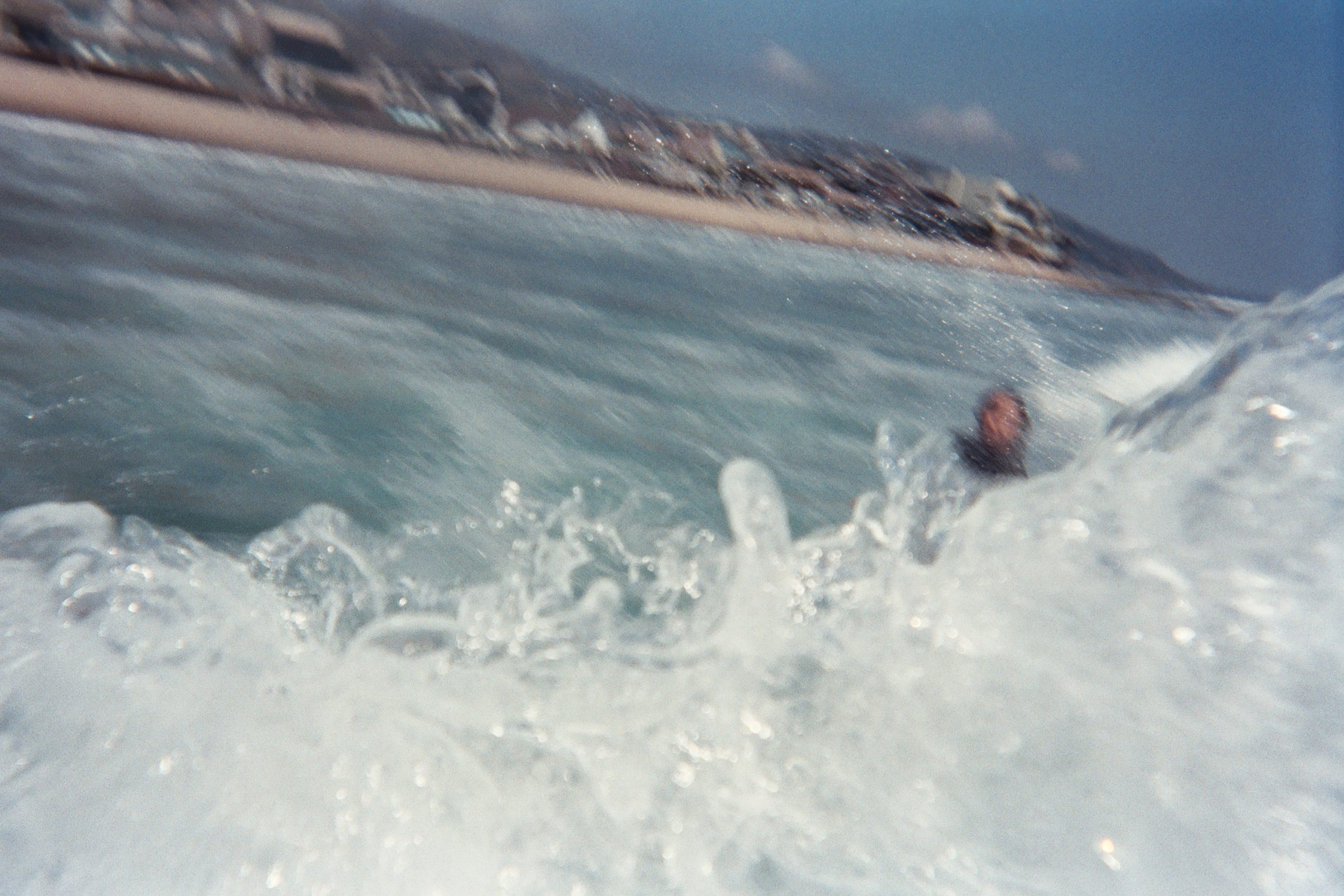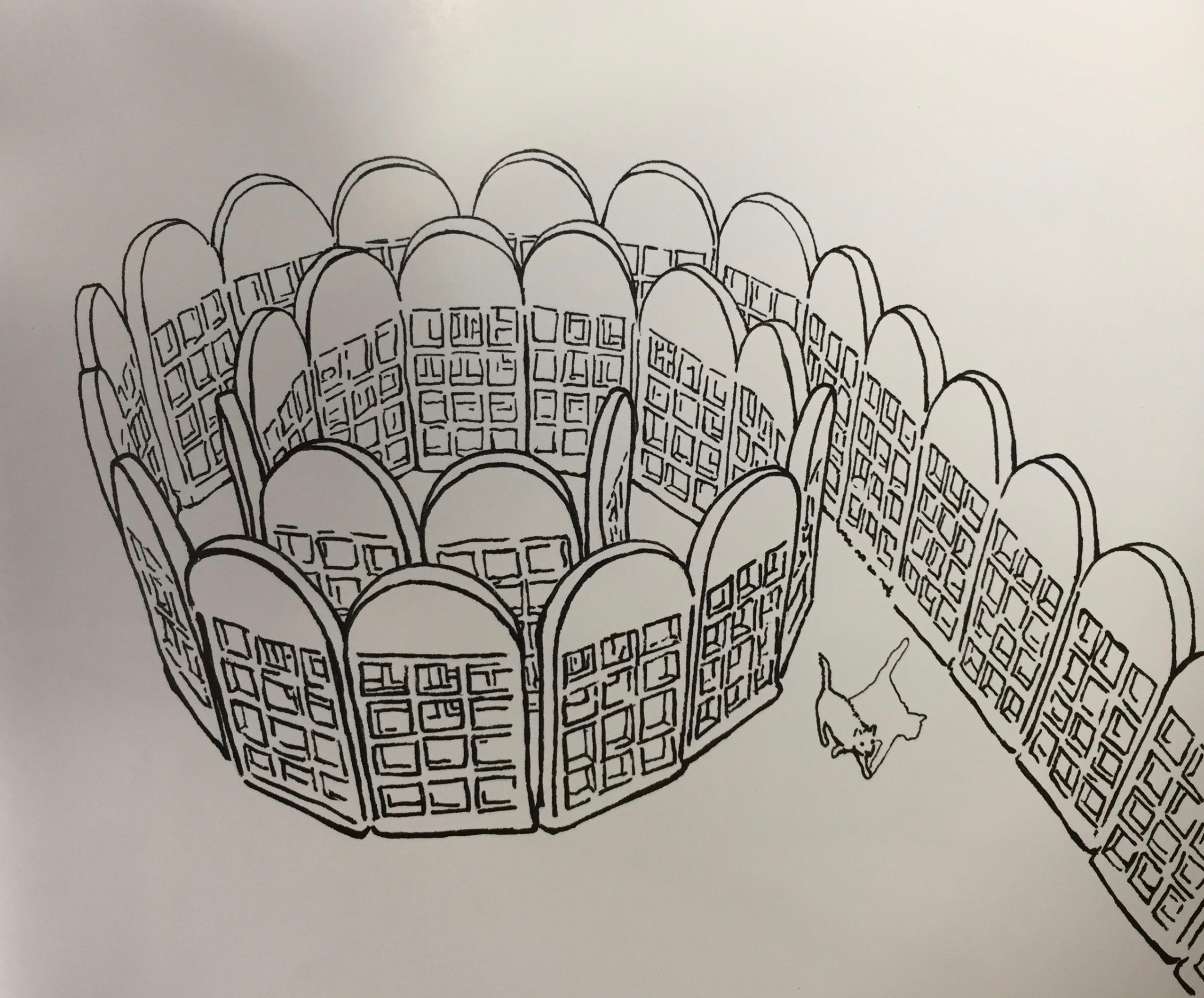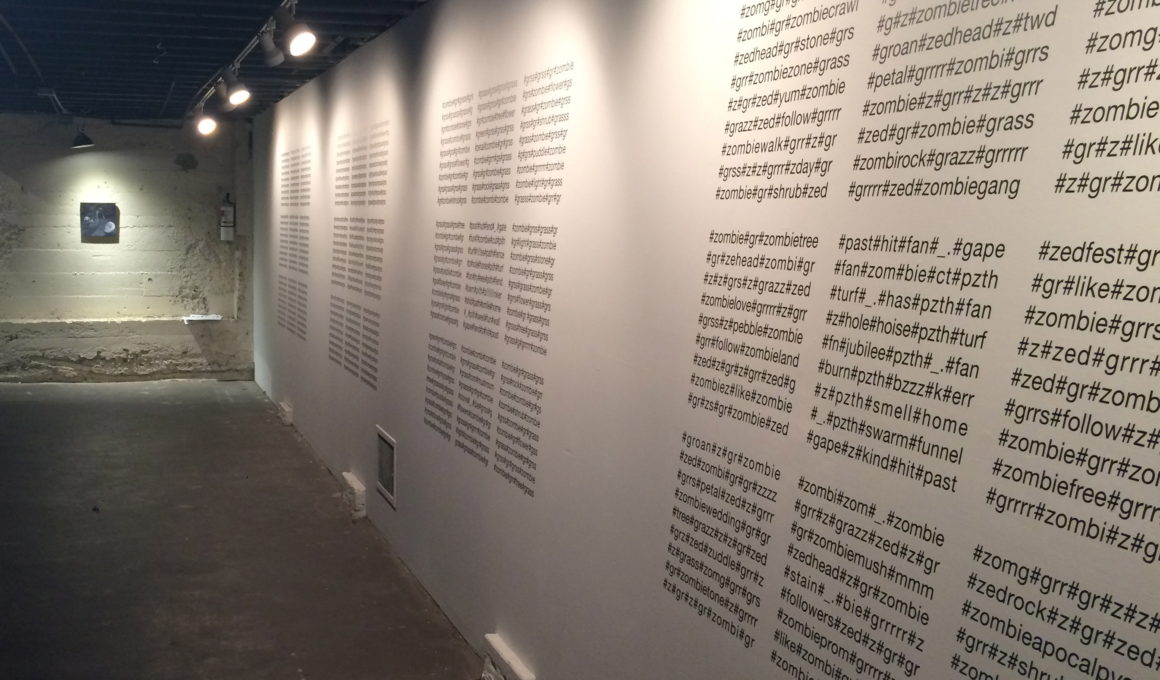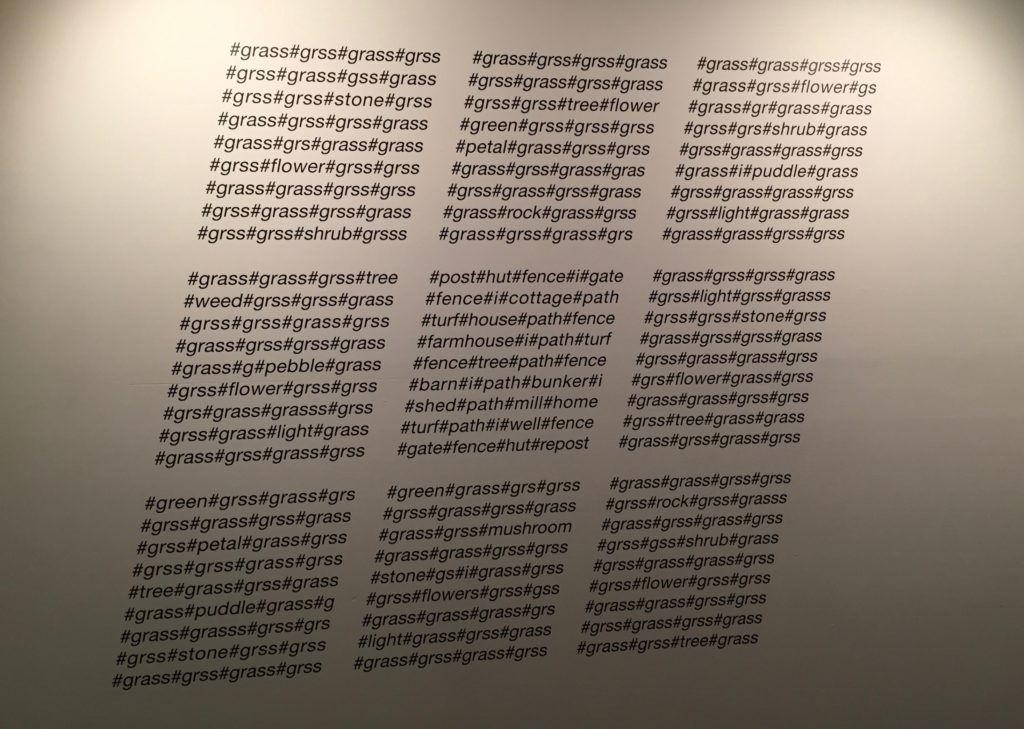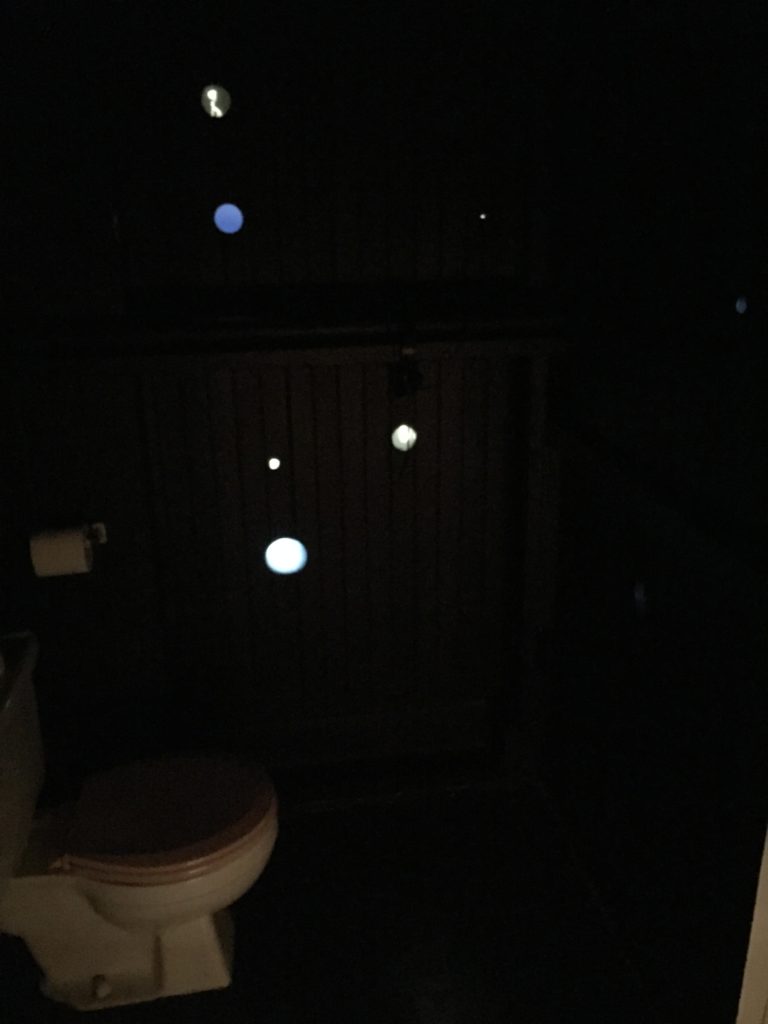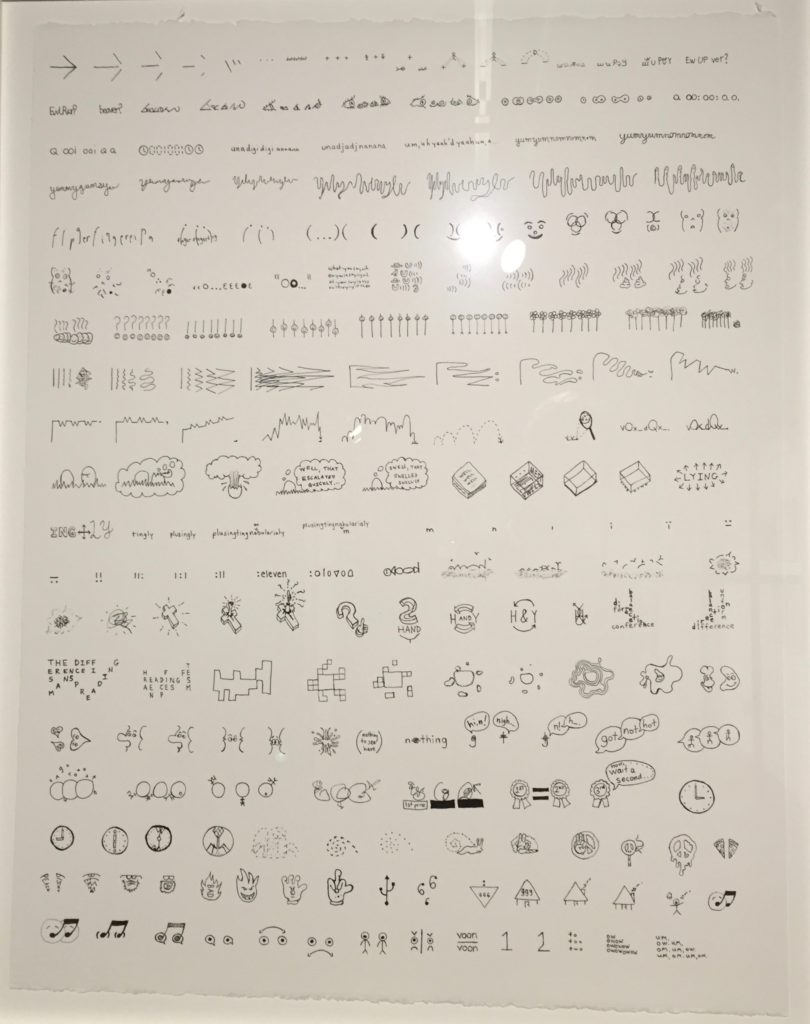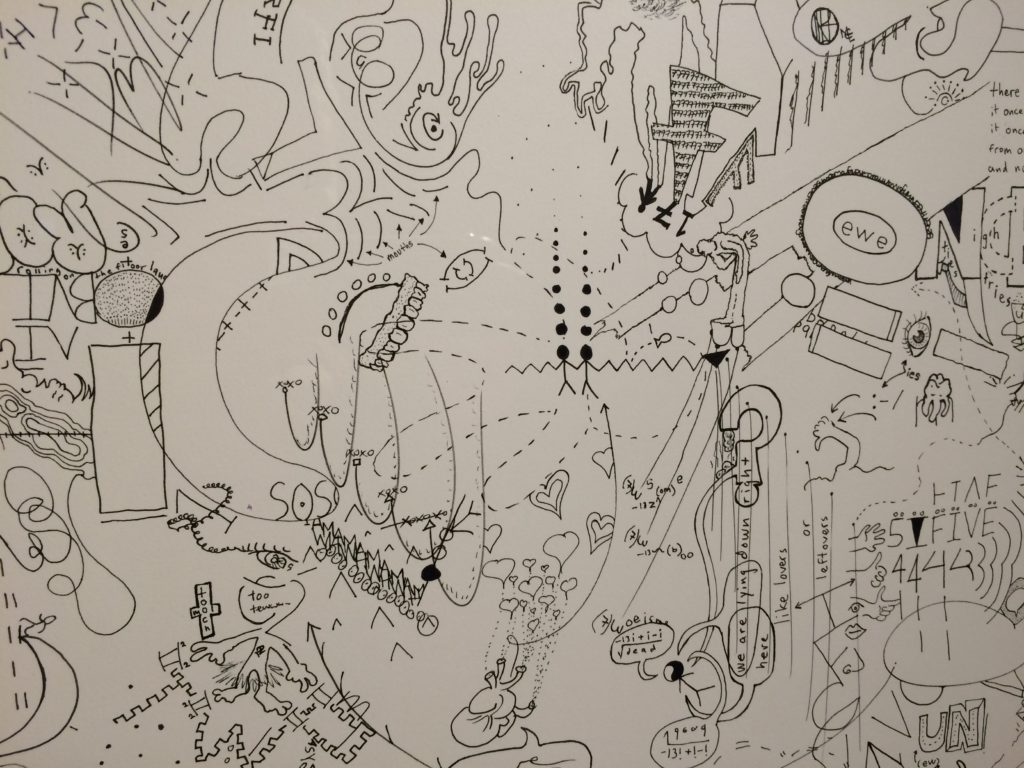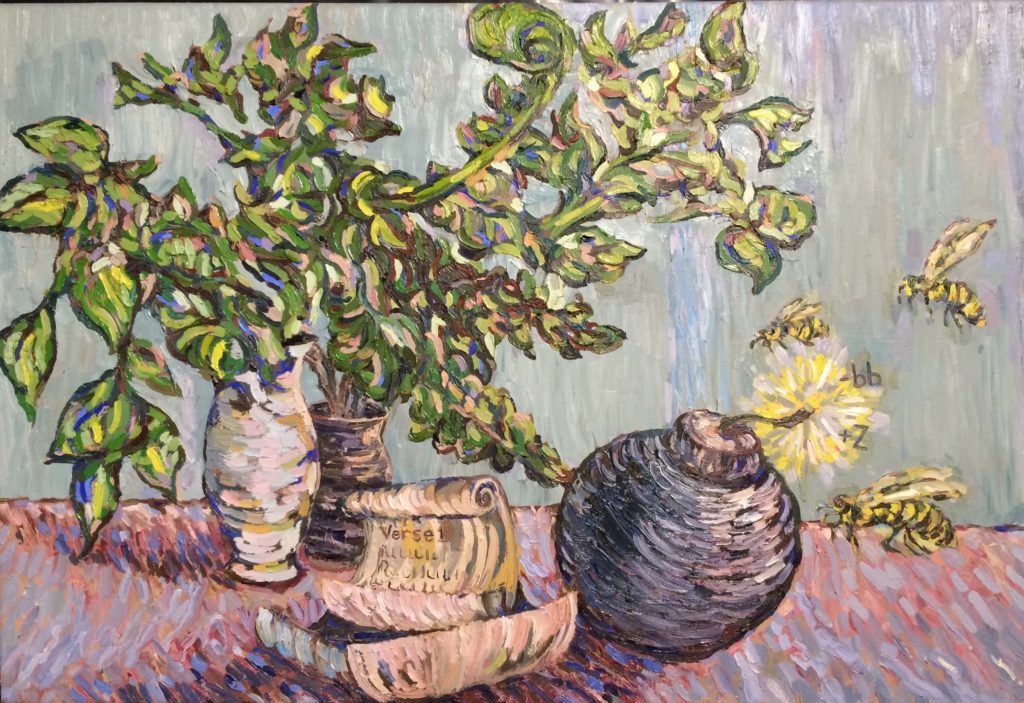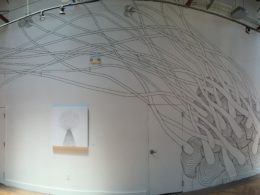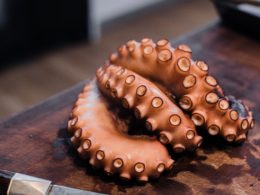The work that first confronts Alter Space’s basement visitors fixates on hash tags.
A synonym for hash tag is “octothorpe,” and in that synonym’s etymology “Stories abound about who first called the # sign an octothorpe. Most stories link the name to various telephone workers in the 1960s,” according the Merriam-Webster. According to the blog Shady Characters, there is a surreptitious etymology. In this version of the term’s history, both the term and the icon come from cartography, where the symbol represents a village surrounded by eight fields. Invented etymology or not, that name and purported conception have become tropes of zombie folklore. The surrounding fields become infiltrated with zombies en route to a zombie takeover of the village/house in the center. The pattern and folklore are evident in zombie movies like Night of the Living Dead, which could be shorthanded using a hash tag representing the living people trapped in a farmhouse surrounded by zombies. That vision is foregrounded by George Pfau and Tom Comitta’s introductory work:
Read from left to right, “the living” are in the center of the first octothorpe (initially surrounded by 8 fields). The next octothorpe continues a shape poem wherein zombies begin visually and linguistically infiltrating the fields ultimately taking over the center square. This drama unfolds exclusively through linguistic ‘characters’ on fields of language. The cannibalism of living-dead eating and ‘turning’ the living is at the heart of Pfau and Comitta’s project.
The octothorpe as setting for this drama in which mishmashes of modern linguistic characters act out a symbolic drama articulates the politics of Zombie Variations succinctly, if cryptically.
The moment that I entered San Francisco’s Alter Space gallery, the gentleman ‘working the front desk’ was occupied with sweeping the light-maple-colored wood flooring of the white-walled ground floor, creating little piles of dust and debris to be discarded. Dead skin, dander, all manner of cast off particles, being collected for money. Turning trash to treasure. Between brush strokes the greeter/sweeper pointed me to the co-founder and curator who was in the rear room, conjoined to the peephole gallery/bathroom that he promptly directed me into. Instrumental music darkly echoed at the bathroom’s threshold while inside the dark, painted-black bathroom words in peepholes balanced the weight of the music.
The bathroom and soundtrack fade quickly on reemerging into the white FWIW exhibit.
Already next to the rear staircase in the rear room where the greeter was now demurely lifting, leaning and shuffling while maneuvering the push-broom: crshhh, crshhh, crshhh. I moved downstairs into the darker basement, where a dimly-lit-except-for-lighting-on-the-art room segues, via black-tarped ‘hallway,’ into another dark room prominently featuring a solitary black prison cell. The dark basement with the prison cell in the rear corner offers the most overt nod to Alter Space’s re-imagining/re-tooling/re-envisioning of the building’s past life as a dual-level leather/bondage store.
Looking at the hash tag display of zombies flooding the octothorpe and my consciousness, the distinct scratching percolates overhead: crshhh crshhh crshhh. Zombies shuffle into the building. Zombies infect my consciousness and prepare to scratch at my cortex. The sweeper moved to the rear of the ground-floor, pushing: crshhh crshhh crshh, a zombie on the prowl, echoing in the chamber of my brain.
Diagonally opposite the octothorpe series, there is a 15-minute video loop. Apparently filmed in one shot, Pfau performs a reading of the Zombie Variation script. The video lent coherence to the multi-media exhibit when scrumptious brain morsels like this were served: “Language is a friend with benefits gnawing at the tongue. Language is a virus from outer space. In English, 26 zombie characters come alive. Zombie Abby, Zombie Becky, Zombie Calvin.” Or here: “And when did your language go viral?” These statements reinforce the statement of the animated octothorpe characters because Pfau and Comitta engage with the pun on “characters” and Zombie Variations is, on one level, about words and the layers of meaning words have and how those meanings affect their translation from a ‘canvas’ to a brain and back out of a mouth or a hand.
Artists animate characters. Whether working with or against the modes that have come before, art is predicated on an awareness of history and the “vocabulary” of different art forms if only because art criticism dictates that it is so. Pfau and Comitta appear to be artists of both literary and visual art traditions, overlaying the two on top of one another throughout the exhibit.
With the visual drama unfolding in front of me, directly overhead, overlaying itself on the video soundtrack, the clawing zombies scratch at the door of my farm: crshhh, crshhh, crshhh.
If you look up animate in Merriam-Webster, the secondary definition of the verb form is “to give life to” bringing the ink of a pen to life is a reanimation akin to the turning of a zombie.
Push broom praxis: crshhh, crshhh, crshh.
My graduate program wanted my writing to be neatly bound, bordered, and sterilized. Liberated of frilly, artistic flourishes. I probably have yet to make a piece of art that needed to exist outside of the internet to be appreciated, but that doesn’t mean I’ve ceased trying.
Loose threads. Valences of meaning are perceived as problematic and even dangerous to many writing teachers. Ever since my senior year in high school, I’ve been fighting to control my meaning. A teacher told me he liked what I was trying to do with a piece of writing that had no punctuation, but that “I had made errors he didn’t think I meant to make.” I got a B+. Initially, the fight to control my grammar and meaning went against my instincts, but now I sometimes attempt to define so rigidly that my writing becomes more obtuse.
Pushing proven practices pathologically: crshhh, crshhh, crshhh.
I write food for the zombies. I hope you enjoy eating my brain.
Push broom practices praxis: crshhh, crshhh, crshh. I feel you scratching at my brain.
Tom Comitta and George Pfau straddle the gap between the Bay Area and Los Angeles just as I do. In a series of animations, the gaps are foregrounded.
Pfau and Comitta refer to an animation sequence of theirs as a “Transition Drawing.” In so naming them, Pfau and Comitta also acknowledge that the work is similar to so-called “Exquisite Corpse” creations of artists within the surrealism movement during the first half of the 1900s. An exquisite corpse drawing is generally one where the first artist draws a portion of a character (the head, for example). The second artist is then given the original sketch with the majority obscured by a simple fold and tasked with adding to the hidden original with a body section created by their imaginative drawing (part two would then be the chest). The process is repeated until each participant has drawn a section of the character, at which point the drawing is revealed, in total, to the participants (one person’s head, another’s chest, another’s legs, feet, etc). The resultant figure is the “exquisite corpse.” In Pfau and Comitta’s iteration however, the artists instead took turns “furthering the evolution of the icons/characters/letters that came before.”
While in 6th grade, some friends and I ‘created’ a game that we could play in class. All that was required was a piece of paper, a pencil, and two or more willing participants.
The game began with a small stick figure drawn somewhere on the page. That figure was engaged in an activity, generally athletic in nature. Once Player One had drawn the figure in action, they passed the paper to Player Two. Player Two converted the leisure activity drawn by player one into an immanent doom scenario; adding something to the drawing threatening to kill the figure unless a miracle transpired. The next player, whether it was Player One again (in a two player scenario) or Player Three (in a larger game), was tasked with subverting the immanent doom scenario, thereby saving the figure’s life and enabling the figure to proceed with their activity. The next player re-subverted, putting the character back in danger, etcetera. These drawings were done with the most minute and intricate penmanship our 6th grade motor-function could muster, leading to dozens of additions on a single page. That swirling imagery yielded a robust story that was often re-articulated to players and non-players alike, thereby becoming its own artifact of storytelling, a lingua-franca shared by the artists and ultimately translatable into “English.”
Our finished works while playing ‘the game’ resembled the “non-linear” Transition Drawings of Pfau and Comitta.
Our middle school version of these drawings slanted strongly sinister as the whole story became one of undying.
Our drawings also had much in common with the works of Rube Goldberg.
crshhh, crshhh, crshhh plying at my parasympathetic system I feel you taking my words into your brain as fuel.
My brain spends every other weekend in Los Angeles, and my conversation spends part of each day there. If you could draw me, I might look like a little stick figure, soul flitting through physical barriers and impossible doom scenarios, existing most palpably in the ether. That, perhaps, is the case with many American lives in 2016.
Rube Goldberg is dead, but when I view his inventions, I see him alive, on stage, performing stand-up comedy.
crshhh, crshhh, crshhh
If a pun is a joke exploiting different meanings of a word, the rebus is a visual pun. Part of Zombie Variations is a series of Rebus’ painted along the lines of classical painting schools. Each painting’s ‘meaning’ is a rebus of a zombie movie title, and the paintings are placed between the larger pieces of Zombie Variations, interrupting the exhibit like panel breaks in a cartoon. Though perhaps they are really the thread that defines the unity of the exhibit
Pfau and Comitta created an app. It is a series of rebus’ that can be articulated to form new art, visually and poetically. They also made a work in the exhibit that exhibits messages using their app language, and which features a tablet on which to test-drive the app (although the tablet may be little-used as people don’t like to touch art in exhibits for fear of being chastised [although perhaps the fearless visitors of a zombie exhibit touch more are than the usual museum visitor]).
I feel myself again rendered within the exhibit by virtue of its having an app as I travel daily to LA ears and “my words” wander the internet to screens distant and varied that I cannot imagine.
The deeper I move into social media, the better I appreciate the language of rebuses. Imagining them interpreted then re-articulated and sprouting new valences of meaning comforts me as I try to get my feet back on the ground each morning.
Words can only be so sterile. Words have multiple meanings. Why attempt to write a conventional essay? It can only be so dead before somebody reads it and brings it to life again. Heaven forbid someone cites that conventional essay and breathes new life into its dead argument. The bible is one of the oldest and most hotly contested pieces of literature. One would think that by now we would have beaten that old horse to death. Perhaps we killed it and beat it back to undead.
Comitta and Pfau are running in another direction by citing the past. Whether through the ‘vocabulary’ of established schools of art re-appropriated into rebus’ of zombie movie titles (themselves a sort of vocabulary), or through creating apps, these two artists self-consciously use alternate meanings and subvert definition. Pfau and Comitta recognize the power of the dead things I am punching with my fingers in a particular order to give a meaning that I mean in particular but which means something else by the time they are pulled back off the screen by the greedy eyes of the living. Or is it the living dead? I’ve over-subverted my metaphor.
crshhh, crshhh, crshhh
Pushing back to the surface of Alter Space, San Francisco sunlight dripping down the white walls, I was struck when my guide reminded me that there were several exhibits on display and cautioned that I not conflate them in my writing. I was struck, because I thought it a pointless comment.
FWIW, the exhibit inhabiting the white space upstairs, is vastly different visually and thematically from Zombie Variations. FWIW is heavily predicated on found-object artworks that force viewers to take critical looks at their J Crew shirts that have been recreated in watercolor, or the recreated, (false?) wood grain of office desks that have also been re-created in watercolor. Then there is a beam that formerly held up a building but which now is tethered at a slant to the wall and holds up one functioning light at an unusable height. Of course I knew there were multiple exhibits on display!
Then I wrote this piece and realized that while I understand Alter Space and these exhibits more profoundly now than I did when I started, I am more convinced than I ever could have been convinced I would be that the exhibits might simply be one exhibit. After all, found objects given new life=undead.
crshhh, crshhh, crshhh
Houston, Keith. “Miscellany № 74: Zombies Always Make a Hash of Things.”Shady Characters. Shady Characters, 30 May 2016. Web. 10 Oct. 2016.


